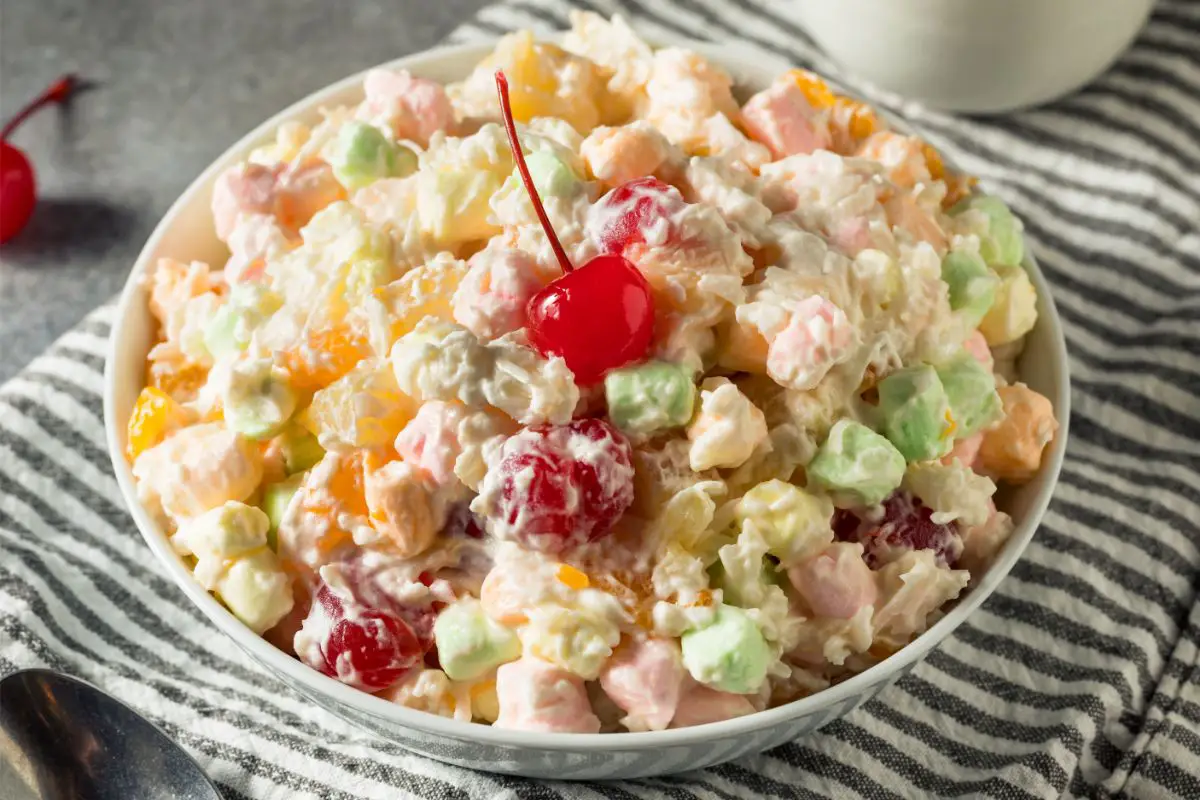Deep within the annals of mythology and culinary lore lies a delicacy that has captured the imagination of ancient civilizations and continues to enchant our taste buds to this day.
Ambrosia, a term steeped in legend and mystique, represents more than just a culinary creation—it symbolizes a divine nectar reserved for the gods!

In this article, we embark on a journey to unravel the mysteries surrounding ambrosia, delving into its origins, mythological significance, and its modern interpretation as a delectable dessert.
Join us as we uncover the secrets of this ethereal concoction and explore its enduring allure throughout history!
What Is Ambrosia?
Ambrosia is a term that carries different meanings depending on the context.
In Greek mythology, ambrosia refers to the food and drink of the gods, which was believed to grant immortality and divine qualities to those who consumed it.
It was considered the sustenance that kept the gods immortal and youthful.
In a culinary sense, ambrosia has evolved into a dessert, typically known as “ambrosia salad” or simply “ambrosia.”
This modern interpretation is a creamy fruit salad that is often enjoyed during festive occasions or as a refreshing dessert.
The ingredients of ambrosia salad tend to include a combination of various fruits such as oranges, pineapples, cherries, and sometimes bananas.
These fruits are mixed with mini marshmallows, coconut flakes, and whipped cream, or a creamy dressing.
The specific ingredients and variations of ambrosia salad can vary depending on regional preferences or family recipes.
Some versions may incorporate additional ingredients like nuts, yogurt, or sour cream. The salad is chilled before serving, allowing the flavors to meld together and create a delightful medley of textures and tastes.
While the modern ambrosia salad may not confer immortality like its mythical namesake, it is a beloved dessert that carries a sense of nostalgia and delight.
It serves as a bridge between ancient legends and contemporary culinary creations, inviting us to savor a taste of both tradition and innovation.
The History Of Ambrosia
The history of ambrosia is deeply rooted in ancient Greek mythology and is closely tied to the beliefs and traditions of the ancient Greeks.
In Greek mythology, ambrosia was regarded as the food of the gods, granting them immortality, eternal youth, and divine qualities.
According to mythological accounts, ambrosia was said to be brought to Mount Olympus, the dwelling place of the gods, by doves.
It was believed to be served by the goddess Hebe, the cupbearer to the gods, or sometimes by Ganymede, the beautiful youth who became the cupbearer of Zeus.
Ambrosia was reserved exclusively for the gods and was often paired with nectar, a divine drink that provided them with strength and vitality.
The consumption of ambrosia had profound implications. The dish ensured the gods’ immortality and conferred exceptional beauty, strength, and wisdom upon them.
The gods were sustained by ambrosia, allowing them to exist beyond the limitations of mortals.
The concept of ambrosia as the food of the gods continued to influence subsequent cultures and literature. It became a symbol of ultimate luxury and pleasure, embodying the divine essence and immortality.
Over time, the concept of ambrosia shifted from a mythical substance to a more tangible culinary creation.
In the modern culinary context, ambrosia has become associated with a fruit salad dessert.
The precise origins of the transformation are unclear, but it is believed to have emerged in the United States during the late 19th or early 20th century.

How To Make Ambrosia
Making ambrosia salad is a delightful and straightforward process. With this in mind, let’s check out a simple recipe to guide you in creating this classic fruit dessert.
Ingredients
- 2 cups of mixed fruits (such as oranges, pineapple chunks, grapes, and cherries)
- 1 cup of mini marshmallows
- 1 cup of shredded coconut
- 1 cup of whipped cream or whipped topping
- 1/2 cup of sour cream (optional)
- 1/4 cup of chopped nuts (optional, such as pecans or walnuts)
- 2 tablespoons of powdered sugar (optional, for added sweetness)
- Maraschino cherries for garnish (optional)
Instructions
Prepare the fruits by peeling and segmenting the oranges, draining the pineapple chunks, and washing the grapes. You can also use canned fruit if preferred. Make sure the fruits are well-drained.
In a large mixing bowl, combine the mixed fruits, mini marshmallows, shredded coconut, and chopped nuts (if using). Gently toss the ingredients together until they are evenly distributed.
In a separate bowl, whip the cream until it forms soft peaks. If using whipped topping, thaw it according to the package instructions.
If desired, you can add sour cream to the whipped cream for a creamier texture and tangy flavor. Fold in the sour cream gently until well combined.
Pour the whipped cream (or whipped topping) over the fruit mixture. Use a spatula or large spoon to gently fold the cream into the fruits, ensuring they are evenly coated.
If desired, sprinkle powdered sugar over the mixture and gently stir to incorporate.
Once everything is well combined, cover the bowl with plastic wrap and refrigerate for at least one hour to allow the flavors to meld together and the salad to chill.
Before serving, give the ambrosia salad a final gentle stir. Garnish with additional shredded coconut and maraschino cherries, if desired.
Serve the ambrosia salad chilled and enjoy!
Ambrosia salad is versatile, and you can customize it based on your preferences.
Feel free to add or substitute fruits, adjust sweetness levels, or incorporate additional ingredients like pecans, walnuts, or even mini chocolate chips.
Final Thoughts
Ambrosia, both as a mythological concept and a modern dessert, carries with it a sense of enchantment and indulgence.
From its origins as the food of the gods in Greek mythology to its transformation into a beloved fruit salad, ambrosia has maintained its allure throughout the ages.
Today, ambrosia has evolved into a delightful dessert that brings joy and nostalgia to many.
The fruit salad variation, with its combination of vibrant fruits, fluffy marshmallows, and creamy textures, offers a sweet and refreshing treat for all occasions.
So, as we relish each spoonful of ambrosia, let us appreciate the rich tapestry of mythology and culinary traditions that it represents!
- How To Make Honey Butter - July 4, 2023
- How To Make Meringue - July 3, 2023
- What Is Shortening? - July 3, 2023








